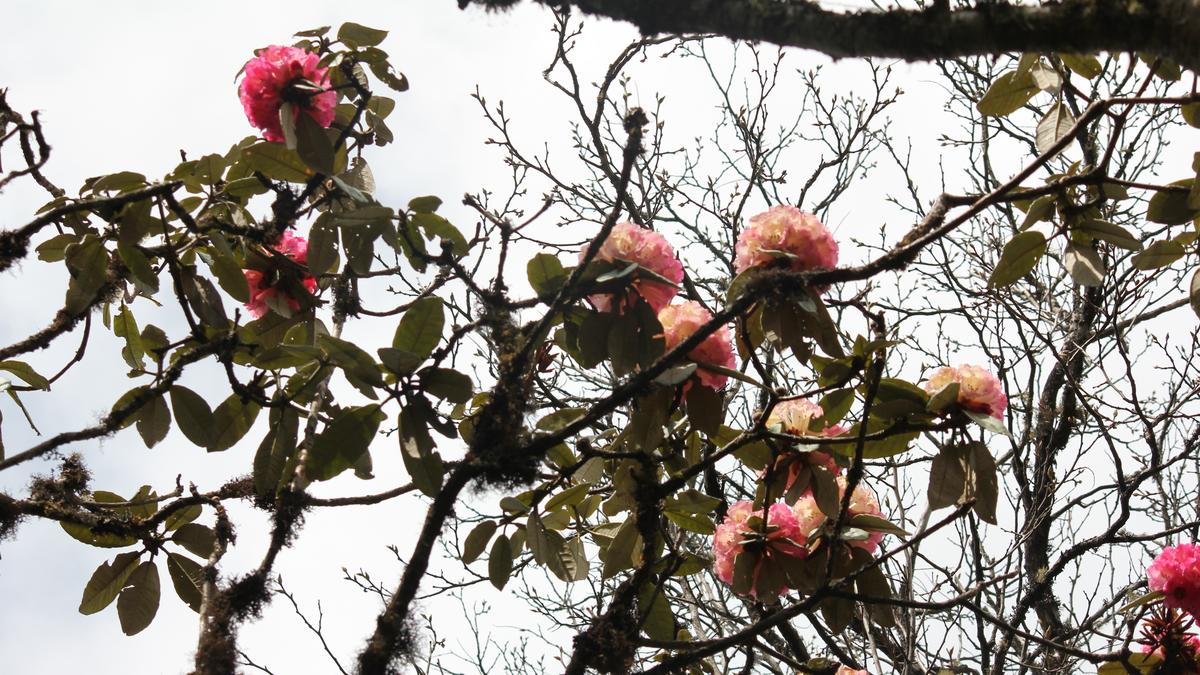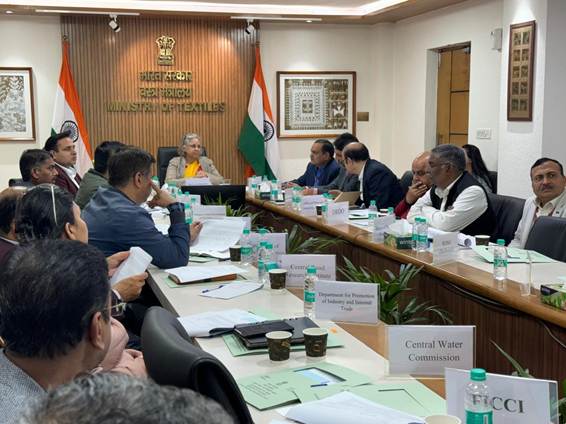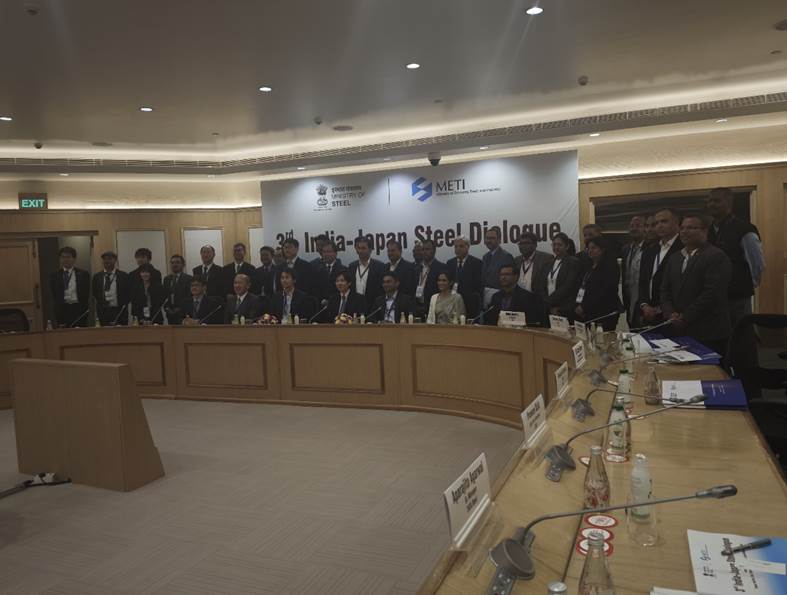Rhododendron wattii

- 10 Feb 2025
In News:
A recent study has highlighted the alarming decline of the rare Rhododendron wattii, a species endemic to Nagaland and Manipur, especially in the Dzukou Valley, Nagaland. The species is now on the brink of extinction due to severe threats to its survival, raising serious conservation concerns.
Botanical Profile
- Taxonomy and Discovery:
- First collected by Sir George Watt during his 1882–85 survey in the Japfu Hill range, Nagaland.
- Belongs to the Rhododendron genus, which has over 1,000 species worldwide.
- India hosts 132 taxa, of which 129 are found in the northeastern region.
- Growth and Habitat:
- Grows as a small tree or shrub in the temperate biome.
- Attains a maximum height of 25 feet.
- Endemic to Manipur and Nagaland, predominantly in the Dzukou Valley at ~2,600 metres altitude.
- Phenological Features:
- Evergreen plant with year-round leaf renewal.
- Flowering: Late February to April.
- Fruiting:April to December.
- Produces trusses of 18–25 pink flowers with dark flecks and purplish basal blotches.
- Pollinated by the Fire-tailed Sunbird (Aethopygaignicauda) and bumble bees.
Conservation Concerns:
- Conservation Status:
- Listed as Vulnerable by the IUCN Red List due to:
- Severe population fragmentation.
- Area of occupancy less than 500 sq. km.
- Botanists at the Botanical Survey of India consider it Critically Endangered in its natural habitat.
- Listed as Vulnerable by the IUCN Red List due to:
- Threats to Survival:
- Poor seedling survivability despite abundant seed production.
- Anthropogenic pressures such as:
- Deforestation
- Habitat destruction
- Use of trees for firewood by local communities.
- Wildfires: A major fire incident in 2020–21 severely impacted the Dzukou Valley.
- The lone surviving Rhododendron wattii tree was recorded far from human trails during a recent field study.
Recent Study Highlights:
- Conducted by Imtilila Jing and S.K. Chaturvedi of Nagaland University.
- Published in the Journal of Threatened Taxa.
- Found only one living tree in the surveyed area of 27 sq. km of Dzukou Valley.
- The last previously reported tree in Nagaland (2012–13) was cut down.
Additional Botanical Development in the Region:
While the situation of Rhododendron wattii is grim, the region also witnessed a positive botanical development:
- Discovery of Phalaenopsis wilsonii, a new orchid species in Manipur’s Senapati district.
- Identified by researchers from the Institute of Bioresources and Sustainable Development (IBSD), Imphal.
- It is the ninth species of the Phalaenopsis genus recorded in Manipur.
GREAT Scheme

- 10 Feb 2025
In News:
The Grant for Research & Entrepreneurship across Aspiring Innovators in Technical Textiles (GREAT) scheme, launched in August 2023 under the National Technical Textiles Mission (NTTM), aims to promote startup-led innovation and entrepreneurship in the rapidly growing sector of technical textiles in India.
As of February 2025, the government has approved four startups under the scheme, providing them with financial assistance to develop commercially viable innovations.
About the GREAT Scheme:
- Objective: To encourage young innovators, scientists, and startups in the technical textiles domain to convert ideas into market-ready products or functional prototypes.
- Implementation: Operated by the Ministry of Textiles under the R&D and Innovation Component of the NTTM.
- Financial Support:
- Grants of up to Rs.50 lakh for a period of up to 18 months.
- 10% upfront contribution from startups (e.g., ?5 lakh for a ?50 lakh grant).
- No royalty or equity required by the government.
- Approved Projects: Focus areas include Medical Textiles, Industrial Textiles, and Protective Textiles.
Complementary Initiatives under NTTM:
Academic and Skill Development:
- Education Institutes:
- ?6.5 crore approved for 3 academic institutes, including IIT Indore and NIT Patna, to introduce new courses in Geotextiles, Sports Textiles, Protective Textiles, and more.
- Skill Training:
- 12 Skill Development Courses launched across application areas such as Medical, Agricultural, Mobile, and Protective Textiles.
- Developed by leading Textile Research Associations: SITRA, NITRA, and SASMIRA.
- Aim to train stakeholders across the technical textile value chain.
National Technical Textiles Mission (NTTM): An Overview
- Launched: 2020
- Nodal Ministry: Ministry of Textiles
- Total Outlay: ?1,480 crore
- Mission Goals:
- Make India a global leader in technical textiles.
- Expand the market size to $40–50 billion with 15–20% annual growth.
- Increase domestic penetration and usage of high-performance technical textiles.
Four Key Components:
- Research, Innovation, and Development
- Promotion and Market Development
- Export Promotion
- Education, Training, and Skill Development
- Sectoral Focus:Agro-textiles, Geotextiles, Medical Textiles, Industrial Textiles, Mobile Textiles, Home Textiles, Sports Textiles, Protective Textiles, and others.
- Policy Support:Includes integration with PLI schemes, PM MITRA Parks, and formulation of quality control regulations to strengthen manufacturing capabilities.
Significance for India’s Development:
- Encourages Atmanirbhar Bharat through self-reliant manufacturing and innovation.
- Strengthens India's competitiveness in high-end technical textiles for defense, healthcare, agriculture, infrastructure, and disaster response.
- Bridges the gap between lab-level R&D and market-ready products, especially by supporting startups in early innovation stages.
Grameen Credit Score

- 10 Feb 2025
In News:
The Union Budget 2025–26 introduced the Grameen Credit Score (GCS) framework as a targeted initiative to enhance access to formal credit for Self-Help Groups (SHGs) and the rural population. It reflects the government’s commitment to financial inclusion, rural empowerment, and inclusive development.
What is the Grameen Credit Score?
- The Grameen Credit Score is a rural-specific credit evaluation framework being developed by Public Sector Banks.
- It aims to formalize the credit behavior and transaction history of SHG members and rural individuals, especially women entrepreneurs, and integrate them into India’s central credit ecosystem.
- Unlike conventional credit scores (like CIBIL or CRIF Highmark), GCS is tailored to assess creditworthiness based on local financial behavior, such as SHG repayment records, informal lending history, and community participation.
Key Features and Objectives:
- Improved Credit Assessment:
- Bridges the gap in the current credit bureau systems, which often overlook rural borrowers and SHG members.
- Uses digital records and behavioral insights to provide a customized and accurate credit profile.
- Financial Inclusion:
- Targets women-led SHGs to provide better access to loans, credit cards, and microfinance products.
- Encourages rural borrowers to understand and monitor credit scores, EMIs, and repayment cycles.
- Customized Financial Products:
- Linked with the introduction of custom credit cards for micro-enterprises with credit limits of up to ?5 lakh.
- Facilitates product innovation for grassroots entrepreneurs in agriculture, MSMEs, and allied sectors.
- Support for Broader Rural Ecosystems:
- Integrated with initiatives like the SVAMITVA Scheme for property records digitization.
- Complements reforms like the transformation of India Post into a rural logistics backbone and support for cooperative sectors via the NCDC.
- Economic Empowerment:
- By expanding credit access and improving repayment discipline, GCS is expected to:
- Boost rural entrepreneurship
- Strengthen economic resilience of rural households
- Support the long-term development of the rural economy
- By expanding credit access and improving repayment discipline, GCS is expected to:
Impact on Rural Development and SHGs:
- Empowers rural women through financial independence and enterprise development.
- Enhances formal credit linkage of SHGs, reducing reliance on informal moneylenders.
- Promotes financial literacy and long-term economic stability in villages.
- Aims to be a catalyst for poverty alleviation and inclusive growth.
Gaia Black Holes

- 10 Feb 2025
In News:
The European Space Agency’s Gaia mission, launched in 2013, continues to redefine our understanding of the Milky Way by detecting celestial phenomena through precise astrometry.
One of its most significant contributions has been the discovery of dormant stellar-mass black holes that are not associated with X-ray emissions—previously the main detection method. These discoveries represent a paradigm shift in black hole detection and open new avenues for astrophysical research.
Gaia BH Series: Discovery and Significance
Gaia BH1
- Discovery Year: 2022
- Location: ~1,560 light years from Earth in the Ophiuchus constellation
- Significance:
- Closest known black hole to Earth
- Detected via a yellow star orbiting a dark mass, whose high orbital velocity implied the presence of a black hole nearly nine times the mass of the Sun
- Validated using data from LAMOST (China) and Magellan Clay Telescope (Chile)
Gaia BH2
- Discovery Year: 2023
- Location: ~3,800 light years away in the Centaurus constellation
- Mass: Around nine solar masses
- Observation Method: Tracked motion of a luminous star orbiting an unseen massive companion
Gaia BH3 – A Landmark Discovery
- Discovery Year: 2024
- Distance from Earth: ~1,926 light years (~2,000 light years), making it the second closest black hole
- Location:Aquila constellation, in the Milky Way’s outer regions
- Mass: ~33 times the mass of the Sun, making it the largest known stellar-mass black hole in the Milky Way
- Orbital Partner: A yellow giant star orbiting every 11.6 years, with an average separation similar to the Sun-Uranus distance
- Special Traits:
- It is a dormant or passive black hole, not actively accreting matter
- Lacks X-ray emissions, suggesting a scarcity of surrounding material
- Its companion star’s chemical composition indicates ancient origins, hinting that such massive black holes were formed early in the universe
Scientific Implications:
- Detection Technique Innovation:Gaia uses astrometric mapping to track the apparent motion of stars across the sky. When a star appears to orbit "empty space," astronomers infer the presence of a massive object—typically a black hole—using Kepler’s laws and the Doppler effect.
- Redefining Black Hole Census:Most black holes were previously detected through X-ray emissions. Gaia has revealed non-emitting black holes, indicating a possibly larger hidden black hole population in our galaxy.
- Historical Linkage:Black holes with masses above 30 solar masses were previously only observed through gravitational waves (LIGO/VIRGO, 2015). Gaia BH3 now provides a local, observable counterpart.
India-Japan Steel Dialogue

- 10 Feb 2025
In News:
The 3rd India-Japan Steel Dialogue was held on February 4, 2025, at Vigyan Bhavan, New Delhi, as part of the institutional mechanism under the Memorandum of Cooperation (MoC) signed between the two nations in December 2020. The dialogue was co-chaired by senior officials from India’s Ministry of Steel and Japan’s Ministry of Economy, Trade and Industry (METI).
Key Highlights and Strategic Focus Areas:
- Bilateral Steel Cooperation:The dialogue served as a platform to deepen cooperation in areas such as technology exchange, workplace safety, product diversification, and capacity building. Both nations reviewed progress under existing initiatives and reaffirmed commitment to long-term collaboration in the steel sector.
- Ease of Doing Business & Investment Support:India reiterated its commitment to facilitating ease of doing business for Japanese companies, while Japan assured continued technological and financial support for investments in advanced steel technologies in India.
- Sustainable Steel Production:India showcased recent initiatives like the Green Steel Report and the Taxonomy of Green Steel, underlining efforts to align steel production with sustainability goals and climate commitments.
- Demographic & Market Advantages:The Indian delegation highlighted the growing domestic demand driven by infrastructure investments, and the potential of India’s demographic dividend to attract foreign investment in the steel sector.
- Global Regulatory Issues – EU CBAM:Both sides discussed the European Union’s Carbon Border Adjustment Mechanism (EU CBAM), which seeks to impose carbon pricing on imports in sectors such as iron and steel, aluminum, cement, fertilizers, electricity, and hydrogen.
- CBAM Phase Timeline:
- Transitional Phase: 2023–2025 (reporting obligations)
- Full Implementation: From 2026 (financial obligations imposed)
- CBAM Phase Timeline:
Relevance:
CBAM has major implications for international steel trade, necessitating cleaner production methods and greater transparency in carbon emissions data.
